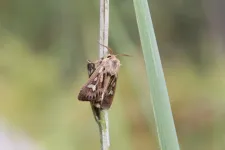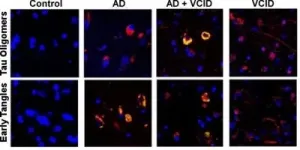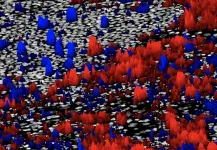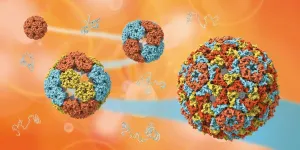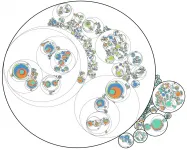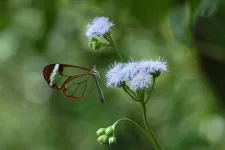(Press-News.org) Climate change exerts great pressure for change on species and biodiversity. A recent study conducted by the University of Helsinki and the Finnish Environment Institute indicates that the few moth and butterfly species (Lepidoptera) capable of adjusting to a changing climate by advancing their flight period and moving further north have fared the best in Finland. In contrast, roughly 40% of Lepidoptera species have not been able to respond in either way, seeing their populations decline.
Climate change is bringing about rapid change in Finnish nature - can species keep up with the pace? Adjusting to climate change can manifest through earlier phenology such as moth and butterfly flight periods, bird nesting, or plant flowering taking place earlier than before. Species can also adjust by shifting their range further north, as individuals relocate to new areas where conditions have become favourable.
The researchers emphasise that, to preserve biodiversity as climate change intensifies, it is of utmost importance to ensure sufficiently extensive, interconnected and habitats of high-quality which make it possible for species to adjust to the challenges generated by climate change.
The study carried out by the University of Helsinki and the Finnish Environment Institute compared temporal shifts in the flight period of 289 moths and butterflies and spatial shifts in their northern range boundary, as well as changes in abundance over a roughly 20-year period.
"Roughly 45% of the species that we studied had either moved northward or advanced their flight period," says Postdoctoral Researcher Maria Hällfors from the University of Helsinki. "They fared much better than the 40% of the species which had not responded in either way. On average, the populations of these poorly responding species had declined. The largest increase in abundance was seen in the 15% of the species that both moved northward and advanced their flight. This demonstrates that the ability to respond to a changing environment is vital for species."
Few species have advanced their phenology
Another interesting finding was the fact that while nearly half of the species had moved northward, only 27% had advanced their flight period.
"This finding deviates from observations made elsewhere in Europe where advancing the flight period has been much more common among Lepidoptera," says Senior Researcher Juha Pöyry from the Finnish Environment Institute.
In Finland, the species that have advanced their flight the most are the ones that overwinter as adults, including the European peacock butterfly. In fact, it appears that Lepidoptera species living in Finland respond more readily by expanding their ranges northward compared to advancing their flight. Species which are found further north than before include the antler moth and the scarce copper.
"It may be that the increasing light in the spring is a more important cue for butterflies and moths to start their flight than temperature on its own," Pöyry adds.
Sufficient habitats are vital
A potential explanation for the infrequency of species responding optimally, that is, by both advancing their flight and moving northward, could be the scarcity of suitable habitats.
"For organisms to be able to respond to climate change by shifting their range further north, sufficient amounts of suitable habitats of high-quality are needed," says Mikko Kuussaari, Senior Researcher at the Finnish Environment Institute.
The amount of habitats important for many moth and butterfly species has decreased, resulting in population decline for many of them. For example, many butterfly species have suffered from a decrease in meadows.
"Declining populations are usually not able to provide a sufficient basis for the species to spread to new areas. Small populations also contain less genetic diversity that could help the local populations adjust by changing the timing of their flight. " Kuussaari adds. Indeed, safeguarding biodiversity requires, above all, the maintenance of sufficiently large and interconnected habitats of high-quality .
Long-term monitoring enables research
The study utilised data on Lepidoptera flight periods collected in two long-term monitoring projects coordinated by the Finnish Environment Institute. Of the two, the Finnish national moth monitoring scheme was launched in 1993 and the butterfly monitoring scheme in agricultural landscapes in 1999. A dataset of citizen observations openly available through the Finnish Biodiversity Information Facility was utilised to calculate species range boundary shifts.
"Without such long-term monitoring schemes and the great contribution of volunteer butterfly and moth enthusiasts in collecting observations, as well as collaboration between different research organisations, it would be impossible to carry out these kinds of analyses encompassing hundreds of species," says Associate Professor Marjo Saastamoinen from the University of Helsinki.
INFORMATION:
Researchers remain perplexed as to what causes dementia and how to treat and reverse the cognitive decline seen in patients. In a first-of-its-kind study, researchers at the Medical University of South Carolina (MUSC) and Beth Israel Deaconess Medical Center (BIDMC), Harvard Medical School discovered that cis P-tau, a toxic, non-degradable version of a healthy brain protein, is an early marker of vascular dementia (VaD) and Alzheimer's disease (AD). Their results, published on June 2 in Science Translational Medicine, define the molecular mechanism that causes an accumulation of this toxic protein. Furthermore, they showed that ...
WACO, Texas (June 9, 2021) - Most people listen to music throughout their day and often near bedtime to wind down. But can that actually cause your sleep to suffer? When sleep researcher Michael Scullin, Ph.D., associate professor of psychology and neuroscience at Baylor University, realized he was waking in the middle of the night with a song stuck in his head, he saw an opportunity to study how music -- and particularly stuck songs -- might affect sleep patterns.
Scullin's recent study, published in Psychological Science, investigated the relationship between music listening and sleep, focusing on a rarely-explored mechanism: involuntary musical imagery, or "earworms," when a song or tune replays ...
June 10, 2021, CLEVELAND: A new Cleveland Clinic-led study has identified mechanisms by which COVID-19 can lead to Alzheimer's disease-like dementia. The findings, published in Alzheimer's Research & Therapy, indicate an overlap between COVID-19 and brain changes common in Alzheimer's, and may help inform risk management and therapeutic strategies for COVID-19-associated cognitive impairment.
Reports of neurological complications in COVID-19 patients and "long-hauler" patients whose symptoms persist after the infection clears are becoming more common, suggesting that SARS-CoV-2 (the virus that causes COVID-19) may have lasting effects on brain function. However, it is not yet well understood how the virus leads to neurological issues.
"While some studies suggest ...
The human heart contracts about 70 times per minute, while that of a rat contracts over 300 times; what accounts for this difference? In a new study publishing 10th June in the open-access journal PLOS Biology, led by Michael Geeves and Mark Wass of the University of Kent and Leslie Leinwand from the University of Colorado Boulder, reveal the molecular differences in the heart muscle protein beta myosin that underly the large difference in contraction velocity between the two species.
Myosin is a "molecular motor" - an intricate nanomachine that forms the dynamic core of a muscle's contractile machinery, burning ...
Pairing sky-mapping algorithms with advanced immunofluorescence imaging of cancer biopsies, researchers at The Mark Foundation Center for Advanced Genomics and Imaging at Johns Hopkins University and the Bloomberg~Kimmel Institute for Cancer Immunotherapy developed a robust platform to guide immunotherapy by predicting which cancers will respond to specific therapies targeting the immune system.
A new platform, called AstroPath, melds astronomic image analysis and mapping with pathology specimens to analyze microscopic images of tumors.
Immunofluorescent imaging, using antibodies with fluorescent tags, enables researchers to visualize multiple cellular proteins simultaneously and determine their pattern and strength of expression. Applying AstroPath, ...
The team say their findings have implications for the treatment of viruses in future.
Researchers from the Universities of York and Leeds, collaborating with the Hilvert Laboratory at the ETH Zürich, studied the structure, assembly and evolution of a 'container' composed of a bacterial enzyme.
The study - published in the journal Science - details the structural transformation of these virus-like particles into larger protein 'containers'.
It also reveals that packaging of the genetic cargo in these containers becomes more efficient during the later stages of evolution. They show that this is because the genome inside evolves hallmarks of a mechanism widely ...
The specific traits of a plant's roots determine the climatic conditions under which a particular plant prevails. A new study led by the University of Wyoming sheds light on this relationship -- and challenges the nature of ecological trade-offs.
Daniel Laughlin, an associate professor in the UW Department of Botany and director of the Global Vegetation Project, led the study, which included researchers from the German Centre for Integrative Biodiversity Research in Leipzig, Germany; Leipzig University; and Wageningen University & Research in Wageningen, Netherlands.
"We found that root traits can explain species distributions across the planet, which has never been attempted ...
It's often cancer's spread, not the original tumor, that poses the disease's most deadly risk.
"And yet metastasis is one of the most poorly understood aspects of cancer biology," says Kamen Simeonov, an M.D.-Ph.D. student at the University of Pennsylvania Perelman School of Medicine.
In a new study, a team led by Simeonov and School of Veterinary Medicine professor Christopher Lengner has made strides toward deepening that understanding by tracking the development of metastatic cells. Their work used a mouse model of pancreatic cancer and cutting-edge techniques to trace the lineage and gene expression patterns of individual cancer cells. They found a spectrum of aggression in the cells that arose, with cells ...
WOODS HOLE, Mass. -- Many animals have evolved camouflage tactics for self-defense, but some butterflies and moths have taken it even further: They've developed transparent wings, making them almost invisible to predators.
A team led by Marine Biological Laboratory (MBL) scientists studied the development of one such species, the glasswing butterfly, Greta oto, to see through the secrets of this natural stealth technology. Their work was published in the Journal of Experimental Biology.
Although transparent structures in animals are well established, they appear far more often in ...
Because of a phenomenon called gravitational locking, the Moon always faces the Earth from the same side. This proved useful in the early lunar landing missions in the 20th century, as there was always a direct line of sight for uninterrupted radiocommunications between Earth ground stations and equipment on the Moon. However, gravitational locking makes exploring the hidden face of the moon--the far side--much more challenging, because signals cannot be sent directly across the Moon towards Earth.
Still, in January 2019, China's lunar probe Chang'e-4 marked the first time a spacecraft landed on the far side of the Moon. Both the lander and the lunar rover it carried have been gathering and sending back images and ...
